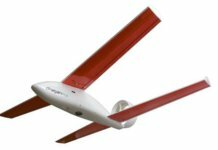The University of Dayton Research Institute (UDRI) in Ohio recently conducted tests to explore the potential impact of a midair collision between a drone and a commercial transport aircraft at 238 mph. In response, however, DJI is calling the study misleading and is demanding UDRI withdraw the research.
According to a news release from the institute, researchers in UDRI’s Impact Physics group launched a 2.1-lb. DJI Phantom 2 quadcopter at the wing of a Mooney M20 aircraft. According to UDRI, the drone did not shatter on impact but tore open the leading edge of the aircraft’s wing as it bore into the structure, damaging its main spar.
“While the quadcopter broke apart, its energy and mass hung together to create significant damage to the wing,” says Kevin Poormon, group leader for impact physics at UDRI.
Although the helicopter returned home with only minor damage to a rotor, Poormon argues it is only a matter of time before a drone strike causes more significant damage to a manned aircraft.
“We wanted to help the aviation community and the drone industry understand the dangers that even recreational drones can pose to manned aircraft before a significant event occurs,” he says. “But there is little to no data about the type of damage UAVs can do, and the information that is available has come only from modeling and simulations. We knew the only way to really study and understand the problem was to create an actual collision, and we’re fully equipped to do that.”
Poormon and his team collaborated with the Sinclair College National UAS Training and Certification Center for the tests. After calibration work to ensure they could control the speed, orientation and trajectory of a drone, the researchers fired a successful shot at the Mooney wing. They then fired a similarly weighted gel “bird” into a different part of the wing to compare results.
“The bird did more apparent damage to the leading edge of the wing, but the Phantom penetrated deeper into the wing and damaged the main spar, which the bird did not do,” Poormon says.
Poormon notes that additional tests using similar and larger drones on other aerospace structures, such as windscreens and engines, could provide more information about how catastrophic a collision could be.
In response to the research, DJI claims that UDRI staged its video to create a scenario inconceivable in real life at a higher speed than the combined maximum speed of the drone and airplane, which is also faster than Federal Aviation Administration testing guidelines. Further, DJI says, UDRI has not disclosed its testing methodology or the resulting data, and while it acknowledged that a similar test with a simulated bird caused “more apparent damage,” it has only promoted the video showing damage from a DJI drone.
In a letter to Poormon, DJI’s vice president of policy and legal affairs, Brendan Schulman, said UDRI “recklessly created and promoted a video that falsely claims to depict a dangerous condition posed by one of our products. … Your public comments deliberately present an entirely improbable, if not impossible, event as a commonplace risk routinely faced by airplane pilots.”
“Unbalanced, agenda-driven research does substantial harm to our industry and to our company,” the letter adds. “Policymakers at all levels of government have responded to sensational media coverage by proposing and enacting new restrictions on drone ownership and use. These limitations prevent people and businesses from using drones safely for beneficial purposes, such as performing hazardous inspections or finding missing people. At least 195 people around the world have been rescued from peril by drones, many of them saved by small drones such as DJI Phantoms. By misleading the public and promoting fear about drones, you are undermining their benefits and encouraging restrictions on their lifesaving uses.”








